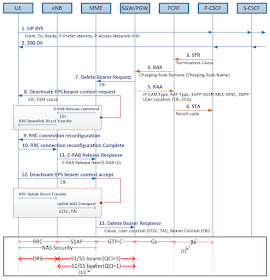When the VoLTE call session does exist, either one of users engaged in the call can release the call session by sending SIP BYE towards the IMS network in a normal case. The user's request comes to the IMS network and it makes a chain reaction from the IMS network to EPC and to the UE. The P-CSCF informs the release of the AF session (i.e., SIP session) to the PGW via the PCRF and the PGW initiates the release of allocated resources for that application. The following scenario shows the case where the user requested to end the voice call session.
[1-2] Upon request from the user, the UE sends SIP BYE towards the IMS network to release the existing SIP session.
[3] The P-CSCF sends Session-Terminating-Request (STR) to inform the PCRF that the established session shall be terminated over Rx, which combines the AF session and the IP-CAN session. As a result of this procedure, the session binding between the AF session and the IP-CAN session is terminated.
[4] The PCRF requests to remove the corresponding PCC rule by sending the Re-Auth-Request (RAR) containing the Charging-Rule-Remove AVP to the PGW. In this example, there are two charging rules to be removed for RTP and RTCP as the voice media session is to be released.
[5-6] The PGW unbinds the PCC rules from the corresponding EPS bearer and responds with the Re-Auth-Answer (RAA) to the PCRF. The PCRF unbinds the AF session from the corresponding IP-CAN and responds with the Session-Termination-Answer (STA) to the P-CSCF.
[7] The PGW sends the Delete Bearer Request containing the EPS Bearer Id (EBI) towards the MME.
[8] The MME requests the eNB to deactivate the EPS bearer context by sending Deactivate EPS bearer context request, which is wrapped by the E-RAB Release Command and RRC Downlink Direct Transfer over S1AP and RRC respectively.
Upon receiving the E-RAB Release Command, the eNB releases allocated resources on Uu and S1 for the corresponding E-RAB(s).
[9-10] The eNB sends the RRC Connection Reconfiguration request to release the radio bearer. The UE releases allocated resources on Uu.
[11-12] The UE responds with the Deactivate EPS bearer Context accept to the MME and the eNB responds with the E-RAB Release Response to the MME.
[13] Upon receiving the E-RAB Release Response, the MME updates the ECM and EMM state of the UE and sends Delete Bearer Response to the SGW/PGW. The SGW/PGW releases allocated resources on S1 and S5.
[1-2] Upon request from the user, the UE sends SIP BYE towards the IMS network to release the existing SIP session.
- Call-ID header is a globally unique identifier of this SIP session. In this context, it will identify the SIP session to be released.
- Route header is a list of IP addresses of intermediary nodes which stays in the signaling path.
- P-Preferred-Identity header indicates the originating user's identity that is preferred by the user to be used.
- P-Access-Network-Info header includes the radio access technologies and cell id.
[3] The P-CSCF sends Session-Terminating-Request (STR) to inform the PCRF that the established session shall be terminated over Rx, which combines the AF session and the IP-CAN session. As a result of this procedure, the session binding between the AF session and the IP-CAN session is terminated.
[4] The PCRF requests to remove the corresponding PCC rule by sending the Re-Auth-Request (RAR) containing the Charging-Rule-Remove AVP to the PGW. In this example, there are two charging rules to be removed for RTP and RTCP as the voice media session is to be released.
[5-6] The PGW unbinds the PCC rules from the corresponding EPS bearer and responds with the Re-Auth-Answer (RAA) to the PCRF. The PCRF unbinds the AF session from the corresponding IP-CAN and responds with the Session-Termination-Answer (STA) to the P-CSCF.
[7] The PGW sends the Delete Bearer Request containing the EPS Bearer Id (EBI) towards the MME.
[8] The MME requests the eNB to deactivate the EPS bearer context by sending Deactivate EPS bearer context request, which is wrapped by the E-RAB Release Command and RRC Downlink Direct Transfer over S1AP and RRC respectively.
Upon receiving the E-RAB Release Command, the eNB releases allocated resources on Uu and S1 for the corresponding E-RAB(s).
[9-10] The eNB sends the RRC Connection Reconfiguration request to release the radio bearer. The UE releases allocated resources on Uu.
[11-12] The UE responds with the Deactivate EPS bearer Context accept to the MME and the eNB responds with the E-RAB Release Response to the MME.
[13] Upon receiving the E-RAB Release Response, the MME updates the ECM and EMM state of the UE and sends Delete Bearer Response to the SGW/PGW. The SGW/PGW releases allocated resources on S1 and S5.
Red Mouse



Hi, can you explain if Volte call is ongoing but RRC is released by EnodeB,when after UE reselection Volte bearer will be established again? If yes can you please explain it will be UE initiated service request from Volte stake in UE or Network initiated by Paging?
ReplyDelete